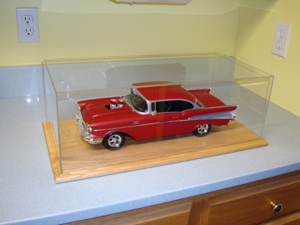Beginner Tips For Building Scale Models
Tip #1: Know your scales!
There are a lot of different sized models to build, and because I mostly choose to build ship models, I have two standard sizes to choose from the various kits on the market. One is the 1:350 scale and the other is the 1:700 scale. The major difference in these is size, and for those who have unlimited room to display their work, the 1:350 scale works great, and the parts are obviously much larger to work with than the 1:700 scale. However, sometimes room is the primary consideration, and then the 1:700 scale works well. With model car, plane and train kits, their scales are entirely different, although I haven’t pursued building these models yet.
Tip #2: Model your interests
I choose a kit personally based on my interests rather than any other consideration. I’m a big WWII buff, and thus, my ship building is all in that era of warship history. One of my recent model ships was the USS Arizona. If you’re unfamiliar with the ship’s history, she was sunk by the Japanese in Pearl Harbor on December 7 with the crew being lost and permanently entombed in her hull where they exist to this day. I choose the 1:350 scale kit because of its size and ease of workability.
Tip #3: Airbrush first and then a brush for details!
I chose acrylic paints and used an airbrush to paint most everything large enough that didn’t require the use of a brush. When using a brush for some of the small parts, I found the enamel paints to give a better result. I start with the hull, without the deck or anything above the deck line and paint the underside first. I found using painters tape works well to mask the waterline and paint that again with the airbrush. Finally, after waiting at least 24 hours for it to dry, I again mask to the upper waterline and paint the sides with the grey. I set this aside and begin on the superstructure.
Tip #4: Construct in units
As a best practice, it’s best to construct the superstructure in units and when assembled, glue them to the deck, which is painted prior to this step. Some like to paint all the parts to a kit before any gluing, but I found it to work better for me to paint the units as a unit. This seems to cover any glue “oops” that might have occurred during assembly.
Tip #5: Apply a coat of Future Floor Wax
It may sound funny, but the last thing I do is to airbrush a coat of Future floor wax to the hull and any place where decals will be applied. This allows the application of decals to stick better. For a beginner, I found trying to apply decals to a flat based paint is a challenge and wouldn’t recommend it . The Future wax works well in the airbrush right from the bottle and leaves a gloss finish. After the decals are applied, I then spray a clear, dull coat acrylic over the ship to give it a realistic finish.
Tip #6: Rig with wire
Once you’ve completed the general construction and painting, the next step is to create the rigging. The rigging is the wire and rope lines that extend across the masts of the ship. There are a lot of ways to achieve this, some people use stretch sprue, some use thread, and others use very fine wire. For a beginner I recommend trying some really thin wire to start. In future articles, I’ll describe more advanced ways to get the perfect rigging, however, this article is devoted to the very early beginner.
Tip #7: Resources for more advanced techniques
In this article, I’m only just touching on the key tips for successfully developing your interest in model building. I haven’t explored anything other than “building right out of the box”. For the advanced modeler, there are amazing and seemingly unbelievable methods and detailing that can be applied like photo etch (PE) details, using custom made barrels for the 16″ guns, etc. I would recommend getting online to some of the forums like steelnavy.com or modelwarships.com and click on the forums pages where you will find numerous posts with wonderful and exciting information on ship building!
Tip #8: Must Have Tools
I would recommend the minimum tools for the beginning scale model building:
- Exacto knife with #2 blades to start
- An assortment of paint brushes for the small hand work. Beginners should obtain some larger brushes since I don’t recommend an airbrush purchase until you’re confident you enjoy the hobby.
- Painters tape (the blue stuff)
- Plastic glue (the one with the needle spout)
- Toothpicks
- Sprue cutters
- Only purchase the paints identified on your first model (don’t overspend on paint again until you’re happy with the hobby)
- Emory board (for smoothing any rough surfaces on the parts)
- A well lit work table space
- Q- tips (used when applying decals, to safely move them around for proper placement)
Finally, the list of necessary items and what I’ve talked about here is for the first time model builder to consider.
These are just the bare minimum tools for successful scale model building. I know, if you get hooked as I did, you’ll end up with an entire work area devoted just to the “tools” you just have to have. Before you start investing in more advanced tools, start simple and slow. You’ll quickly find scale modeling can be quite the investment in the hobby.
Remember to select a model, whether it’s planes, trains, boats, automobiles, and make it something you have a real interest in. It just makes the whole experience a pleasant one. Make sure you save the first model you build to measure your improvement with time and practice. I still have my first model and thankfully, I’ve improved!
Have fun and keep modeling alive.


